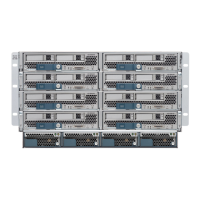3-9
Cisco UCS Invicta Scaling System Administration and Configuration Guide, Version 5.0.1.1a
Chapter 3 SSR Configuration
Volume Group and Node Settings
In Scaling System terminology, a Volume Group (VG) is the logical storage. VG are presented to the
system as one large storage unit. This section provides information on creating, deleting and
provisioning VG storage.
To access the Volume Groups/Node Setting window, do the following:
Step 1 Choose SSR Configuration > VG/Node Settings.
The VG/Node Settings window appears.
• A performance graph at the bottom of the VG/Node Screen displays the logical space utilization of
each VG.
• The ALL tab displays an aggregate logical space utilization of the Volume Groups.
Important Volume Group characteristics include:
• Several performance-type SSNs (physical storage) can be combined to form a VG.
• Multiple Data Reduction SSNs cannot be used to create a VG.
• Each Data Reduction SSN should be created as a VG.
• Combining a Data Reduction and a performance SSN to form a VG is not permitted.
The Volume Group configuration that is optimal depends on the node performance type, business/BCP/
needs and requirements.
Note Only those who were assigned roles with the associated permissions can view and/or access these tasks.
The Volume Group/Node Settings right-click menu provides an option to create a LUN and to delete a
Volume Group. In addition, Cisco UCS Invicta Scaling System SSNs with Data Reduction also displays
the physical space and storage trend.
Physical Space (Data Reduction)
When the Physical Space option is selected from the right-click menu, the following information is
provided:
• Total Size
• Available Free Space
• Data Reduction Savings
Caution Avoid filling up a LUN to its storage capacity as this may cause the system to become unresponsive.
Storage Trend (Data Reduction)
Storage Trends are used as a predictive tool to approximate how many days of storage use remain before
the storage system is fully saturated. Trends are based on data captured daily on the amount of storage
remaining.

